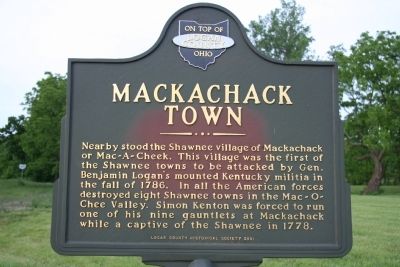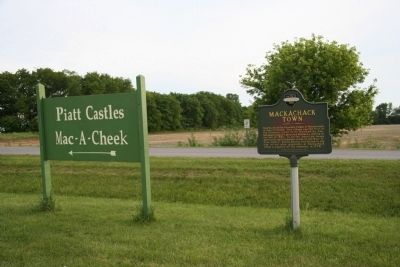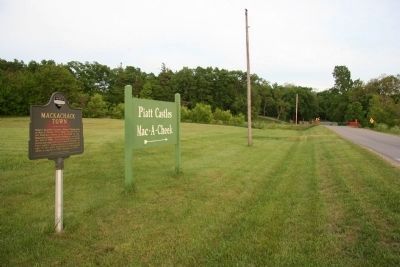Near West Liberty in Logan County, Ohio — The American Midwest (Great Lakes)
Mackachack Town
Logan County, On Top of Ohio
Nearby stood the Shawnee village of Mackachack or Mac-A-Cheek. This village was the first of the Shawnee towns to be attacked by Gen. Benjamin Logan's mounted Kentucky militia in the fall of 1786. In all the American forces destroyed eight Shawnee towns in the Mac-O-Chee Valley. Simon Kenton was forced to run one of his nine gauntlets at Mackachack while a captive of the Shawnee in 1778.
Erected 2001 by Logan County Historical Society.
Topics. This historical marker is listed in these topic lists: Native Americans • Wars, US Indian. A significant historical year for this entry is 1786.
Location. Marker has been reported missing. It was located near 40° 15.053′ N, 83° 43.786′ W. Marker was near West Liberty, Ohio, in Logan County. Marker was at the intersection of Ohio Route 245 and Township Road 47, on the right when traveling east on State Route 245. This historical marker is located 1.4 miles east of West Liberty, Ohio on State Route 245, which follows the course of Macochee Creek. This marker is situated within viewing distance of the historic Piatt, Mac-A-Cheek Castle. Touch for map. Marker was in this post office area: West Liberty OH 43357, United States of America. Touch for directions.
Other nearby markers. At least 8 other markers are within walking distance of this location. Squaw Rock (within shouting distance of this marker); Industry on the Macacheek (about 800 feet away, measured in a direct line); From Generation to Generation (about 800 feet away); Over a Century of Tours (approx. 0.2 miles away); A Castle as a Farmhouse (approx. 0.2 miles away); Let's Play (approx. 0.2 miles away); Who's in the Dog House? (approx. 0.2 miles away); Storing the Crops, Livestock and Machinery (approx. 0.2 miles away). Touch for a list and map of all markers in West Liberty.
Regarding Mackachack Town. In his book, "Buckeye Battlefields" (copyright 1999), author Edwin A. Kramb states the following regarding General Benjamin Logan's 1786 raid on Indian villages in Ohio:
"In the summer of 1786, General George Rogers Clark, at his home in Louisville, received an intelligence report that indicated a large Indian army with some British agents were to assemble on the upper Wabash in September or October. Clark immediately organized a force of militia to counter this anticipated Indian assembly and to retaliate for all the Indian raids of the past summer. Some 2,000 militia troops gathered in Louisville on 10 September, and General Clark led them
north into the upper Wabash River area in present-day Indiana. In addition, Clark ordered Colonel Benjamin Logan to collect another militia force and to lead his force into the upper Miami River valley against the Shawnee villages as a diversionary strike. These thrusts into Indian lands were to take place at the same time."
"Colonel Logan assembled approximately 800 militia troops at Limestone (Maysville). They crossed the Ohio River in the last days of September and moved north. They moved almost directly north from Limestone to the Shawnee village of Mackachack on the upper Mad River. Mackachack was located near the present-day town of West Liberty, Ohio. Logan's army arrived in the vicinity of Mackachack around noon on the 6th day of October. He had organized his troops into three columns. The left column was ordered to attack a smaller Indian village on the west bank of the Mad River opposite Mackachack. The center and right wing would attack Mackachack proper. The order was given, and the army charged quickly toward their objectives."
"Most of the Shawnee warriors were attending that large assembly of Indians that caused the great concern of General Clark. Therefore, they were not present to defend their own villages when Colonel Logan's attack occurred. Logan easily overran Mackachack and captured a number of prisoners. Logan's men then proceeded to attack
and destroy several other Shawnee villages that were nearby."
"The assault against the Shawnee villages by Logan's men continued for two days. Wapatomica, located about four miles east-southeast of the present-day city of Bellefontaine, Ohio and Wapakoneta, located at the present-day city of Wapakoneta, Ohio, were among those villages that were destroyed by Logan's army. At a cost of three men killed and three others wounded, Colonel Logan's raiders then reassembled for their withdrawal. They had killed 22 Indians, captured 33 prisoners who were mostly women, destroyed more than 8 villages, and burned a large amount of foodstuffs and fields of crops. Several of the Indian casualties, however, may be more accurately characterized as murder. For example, an old Shawnee chief by the name of Moluntha was killed by a member of Logan's army after the old chief had surrendered. The killer was a survivor of that ambush at Blue Licks which occurred more than four years ago, but he killed Chief Moluntha in revenge for that long ago disaster."
"On 8 October, Logan issued the order to withdraw back to Limestone. They arrived at the Ohio River in less than a week, and there the army disbanded. The raid on Mackachack was considered quite successful when compared to General Clark's main raid up the Wabash. Clark's army progressed only part way to their destination before supply
problems, desertion problems, discipline problems, and other problems forced the General to withdraw back to Louisville without making any attack."
In some respects, Logan's raid on Mackachack and the other Shawnee villages had the opposite effect than that desired. In addition to being considered a retaliatory strike, many Americans had expected the raid would also intimidate the Shawnee and perhaps bring an end to the Indian raids on their settlements. But rather than intimidate, the raid caused the various groups of the Shawnee Tribe to join forces. They then became more aggressive and posed a greater threat to the American settlements than before Logan's raid. Life on the American frontier continued, then, to be quite a challenge for the Americans."
Also see . . .
1. Benjamin Logan. This link is published and made available by, "Ohio History Central," an online encyclopedia of Ohio History. (Submitted on June 9, 2009, by Dale K. Benington of Toledo, Ohio.)
2. Simon Kenton. This link is published and made available by, "Ohio History Central," an online encyclopedia of Ohio History. (Submitted on June 9, 2009, by Dale K. Benington of Toledo, Ohio.)
3. Simon Kenton. This web link was both published and made available by, "Touring Ohio." (Submitted on June 9, 2009, by Dale K. Benington of Toledo, Ohio.)
4. West Liberty. This web link was both published and made available by, "Touring Ohio." (Submitted on June 9, 2009, by Dale K. Benington of Toledo, Ohio.)
Additional commentary.
1.
As of 8-17-2022 marker has been damaged/removed.
post is damaged, but remains.
— Submitted August 17, 2022, by Rev. Ronald Irick of West Liberty, Ohio.
Credits. This page was last revised on August 11, 2023. It was originally submitted on June 9, 2009, by Dale K. Benington of Toledo, Ohio. This page has been viewed 2,897 times since then and 137 times this year. Photos: 1, 2, 3. submitted on June 9, 2009, by Dale K. Benington of Toledo, Ohio. 4. submitted on November 20, 2022, by Trevor L Whited of Kokomo, Indiana. 5. submitted on July 27, 2023, by Rev. Ronald Irick of West Liberty, Ohio. • Craig Swain was the editor who published this page.




